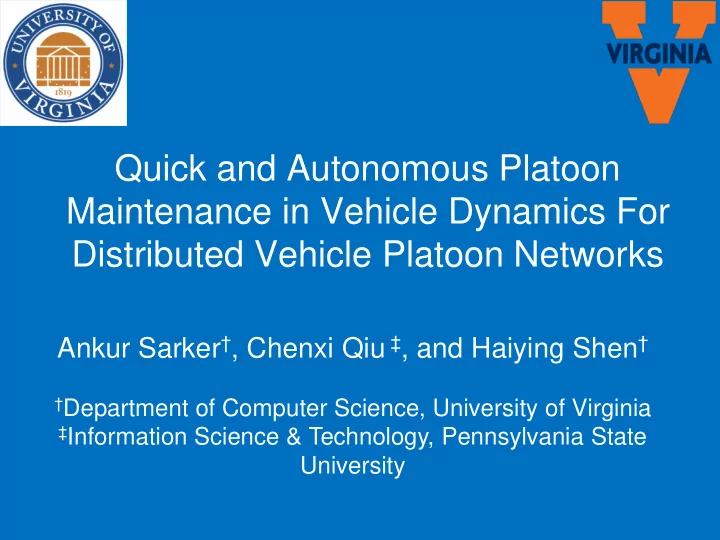

Quick and Autonomous Platoon Maintenance in Vehicle Dynamics For Distributed Vehicle Platoon Networks Ankur Sarker † , Chenxi Qiu ‡ , and Haiying Shen † † Department of Computer Science, University of Virginia ‡ Information Science & Technology, Pennsylvania State University
Outline • Introduction • System Design • Performance Evaluation • Conclusion 2
Introduction Platoon system In a platoon, one leader vehicle and several follower vehicles drive in a single lane, maintaining a safety inter-vehicle distance . . . 3
Introduction Solution: Distributed CACC system 1. Vehicles have short range communication devices 2. Guarantee vehicles’ safety 3. Increase the number of vehicles 4. Dynamic formation of platoon 4
Introduction Solution: Distributed CACC system 1. Vehicles have short range communication devices 2. Guarantee vehicles’ safety 3. Increase the number of vehicles 4. Dynamic formation of platoon 5
Introduction Solution: Distributed CACC system 1. Vehicles have short range communication devices 2. Guarantee vehicles’ safety 3. Increase the number of vehicles 4. Dynamic formation of platoon … … … 6
Introduction Solution: Distributed CACC system 1. Vehicles have short range communication devices 2. Guarantee vehicles’ safety 3. Increase the number of vehicles 4. Dynamic formation of platoon 7
Introduction Challenge of distributed platoon system Platoon maintenance in dynamic environment Without any communication without any accurate distance information 8
Introduction Challenge of distributed platoon system Platoon maintenance in dynamic environment Without any communication without any accurate distance information Our method: Autonomous platoon maintenance 1. Study velocity profiles Analyze velocity profiles for different scenarios 2. Stored velocity profiles Based on different inter-mediate distances and velocities, stored different profiles 3. Adaptive platoon maintence Use mainly two set of profiles for creating or recovering holes inside platoon 9
System Design Velocity profiling Study velocity profiles for two cases: Vehicle leaving: Following vehicles must accelerate gradually maintaining safety and comfort. Vehicle leaving 10
System Design Velocity profiling Study velocity profiles for two cases: Vehicle leaving: Following vehicles must accelerate gradually maintaining safety and comfort. Vehicle leaving Vehicle entering: Following vehicles must deaccelerate gradually maintaining safety and comfort. Vehicle entering 11
System Design Velocity profiling Then, study velocity profiles wrt distances and velocities: Initial velocity changes are similar due to Vehicle leaving deceleration/acceleration limits. Changes of velocity wrt different distances Thus, store mainly two different velocity profiles considering different scenarios. 12
System Design Overview VACP: Vehicle ACcelerating Profile VADP: Vehicle ADjusting Profile v: velocity t: time 13
Experiment Simulation settings 1. One leader vehicle and thirty follower vehicles Velocities are changed from 8m/s to 30m/s The vehicular inter-mediate distance varies from 47.5m to 80m Velocities are changed at every 0.1 second (if necessary) 2. 3 scenarios- Platoon maintenance Vehicle joining Vehicle leaving Compared methods 1. Kyongsu Yi and Young Do Kwon. 2001. Vehicle-to-vehicle distance and speed control using an electronic-vacuum booster. JSAE review 22, 4 (2001), 403 – 412 14
Experiment Platoon maintenance Metric: Safety violation (inter- vehicular distance< safety distance) Observation : Safety violations of two methods are almost similar Reason : The stored velocity profiles are very similar to the optimal velocity profile Safety violations 15
Experiment Platoon maintenance Metric: Recovering hole (distance information is unavailable) Observation : Optimal method causes more unrecovered holes Reason : Optimal method needs neighbor vehicles’ information Recovering hole 16
Conclusions 1. We proposed a decentralized platoon maintenance mechanism 2. We conducted velocity profiling study 3. We devised autonomous vehicular control strategy Future work 1. Consider complex road structures 2. More practical experiments in different traffic conditions 17
Thank you! Questions & Comments? Ankur Sarker as4mz@Virginia.edu Ph.D. Candidate Pervasive Communication Laboratory University of Virginia 18
Recommend
More recommend